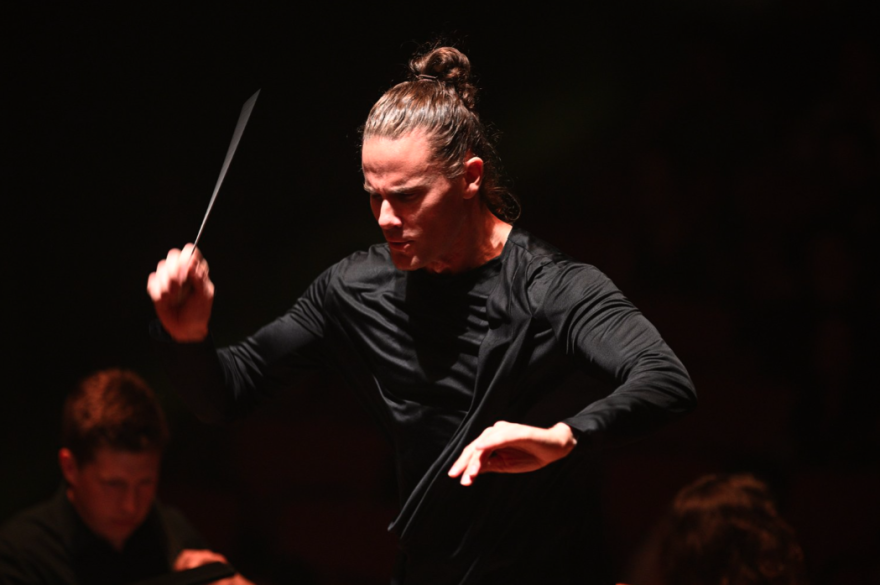Radiohead’s 1997 album “OK Computer” is a masterpiece of millennial dread, full of eerie soundscapes and lyrics referencing dislocation and alienation.
The British band released it 121 years after Johannes Brahms debuted his epic Symphony No. 1, a piece in which he grappled with the inheritance from musical greats who preceded him.
St. Louis Symphony Orchestra will perform “Brahms X Radiohead,” an unlikely fusion of the two pieces, in a concert at the Stifel Theatre on Saturday.
Conductor-arranger Steve Hackman crafted the piece. Also in his repertoire are similar pairings of Beethoven/Coldplay, Aaron Copland/Bon Iver and Tchaikovsky/Drake.
Hackman studied music at the University of Illinois and the Curtis Institute of Music, where he juggled his interest in conducting, playing piano and arranging vocal parts for an a capella group.
One professor advised him to narrow his efforts.
“I remember him telling me, ‘If you’re serious about this, if you want a career in classical music, you need to forget this a capella stuff and this popular music stuff.’ He was well-meaning but he was wrong,” Hackman said. “That might have been the right advice for someone else. But I’m so glad I pursued it all in parallel.”
St. Louis Public Radio’s Jeremy Goodwin asked Hackman about the concept behind his musical mashups and why the pairing of Radiohead and Brahms works.

Jeremy D. Goodwin: When you started creating these arrangements and performing them with orchestras, what did musicians think about it? Were they on board with what you wanted to do?
Steve Hackman: It's been a long journey. Over the years, there's been more and more understanding about what the purpose and what the mission of this work is. And therefore, there's been more acceptance. But I'd be lying if I didn't say at the beginning, it was pretty brutal. Musicians were appalled.
But you have to understand, to be a member of a world-class symphony orchestra, you need to devote your entire life to that craft. And so you have to forgive that musician if they maybe don't know the music of Radiohead, or Drake, or maybe they're not aware of remix techniques or fusion techniques, or what's going on in the more popular and contemporary musical worlds. You can understand why they’re purists. This music means so much to them. It's their life. It's their livelihood. And I'm one of those people. There's a side of me that says the Brahms' first symphony is perfect, so why would you change anything?
Goodwin: So why do you do it?
Hackman: I do my best job to communicate to musicians that it’s to celebrate who they are, what they do, and this art form that we love. And to continue to fight to keep it relevant. It's to celebrate this repertoire and what they do.
It’s to build bridges, to develop new audiences and to create relationships with people that haven’t grown up with classical music, or haven’t been to a symphony hall — or maybe view the symphony hall as an unsafe place, which is true for many people. We have to meet them where they are.
Goodwin: Thinking of Brahms’ first symphony and Radiohead’s “OK Computer,” what do they have in common?
Hackman: They share this very deep and intense anxiety, this brooding feeling. In Radiohead’s case, they were expressing their misgivings about essentially the digital age. We were becoming so much more connected, but yet we're as distant from one another as ever.
In Brahms’ case, he was looking behind him. He had been dubbed the successor to Beethoven. Just consider the kind of pressure that would put on a young composer. So he knew that with his first symphony, he would be judged. And so he took about 20 years to write this piece. And woven into every note, especially in the first movement, you can hear that desperate desire for him to prove himself. You can feel that tension. I think that’s why this really works.
Goodwin: What are some moments in your piece where you feel that the synergy is really working?
Hackman: Gosh, I can think of a lot of moments. “Climbing Up the Walls” is fused with the development section of the first movement. That lyric, “climbing up the walls,” is repeated over and over as the Brahms harmonies soar upward. The orchestra crescendos and reaches the very tumultuous climax of that development.
A moment that contrasts moods is “No Surprises,” which is married with the second movement of the Brahms. I think the end of the second movement is some of the most breathtakingly beautiful music that Brahms wrote. And the Radiohead song, of course, is bittersweet. It’s a beautiful, pleasant-sounding song, but it’s heartbreaking and mournful. I interpolate that line, “such a pretty house, such a pretty garden” and that’s a moment that I think is profound.
Goodwin: What are you working on next?
Hackman: We're just coming off doing several performances of “The Resurrection Mixtape,” which is a fusion of Mahler's second symphony with the music of the Notorious BIG and Tupac Shakur. That's a piece that means a lot to me.






